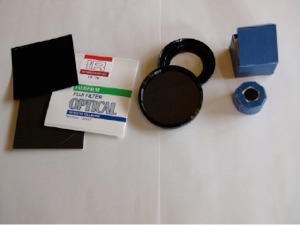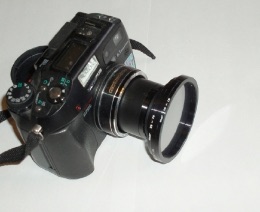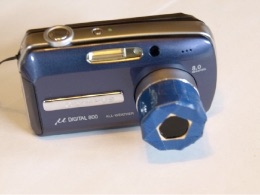Atelier Bonryu(E)
infrared photography


Atelier Bonryu(E)
infrared photography


Laboratory: Infrared Photography
Taking Infrared Photographs
2-2 Filters
Filter Transparent to Infrared but Opaque to Visible Lights: As described so far it is necessary to load a filter transparent to the infrared light and opaque to the visible light in order to take an infrared photograph. Fortunately this kind of filters is easily obtainable. In the case of a lens for an SLR camera (or a mirrorless SL camera) there is a screw for mounting a filter and a glass disk filter mounted on a metal frame such as Kenko Pro1d R72 can be used for the purpose. However, such a disk filter cannot be loaded to many point-and-shoot cameras as the taking lenses of such cameras have no screws for loading filters. Therefore, it is convenient to use a sheet-type filter as a gelatin filter (Figs.2-3, 2-4). Moreover, a gelatin filter is rather inexpensive in comparison with a metal framed disk filter and I sometimes use this type of a filter even for an SLR camera by making a hand-made metal framed disk filter by sandwiching a sheet-type filter between a step-up ring and a step-down ring. In order to load the filter for a point-and-shoot camera I made a tubular filter by pasting a sheet-type filter at one side of a cardboard pipe and inset it to the lens of the camera (Figs.2-4,2-5).
Sheet-type Filters: The filter opaque to visible lights and transparent to infrared lights looks a black opaque filter when we see it directly. In Japan sheet-type filters are produced by Fujifilm Co. These filters for the infrared photography are named as “IRxx” (xx: numbers). I often use a filter IR76 which blocks lights with wavelength less than 760 nm. As 760 nm is the boundary wavelength between the visible and the infrared lights the IR76 filter is easy-to-use filter for the infrared photography. By the way sheet-type filters by Fujifilm is not geratin filters by rights but TAC (tri-acetyl cellulose) filters, but a sheet-type filter is often called as a gelatin filter by photographers.



Fig.2-3 Olympus Camedia 5060 camera with a filter for infrared photography made of a sheet-type filter IR76 with a step up and a step down rings.
Fig.2-4 From left to right: TAC filter IR76, a disk-type filter made of IR76, a step up and a step down ring, a tubular filter for Olympus mu Digital 800 made of a cardboard pipe.
Fig.2-5 Olympus mu Digital 800 camera with a tubular filter made of IR76 and a cardboard pipe.




